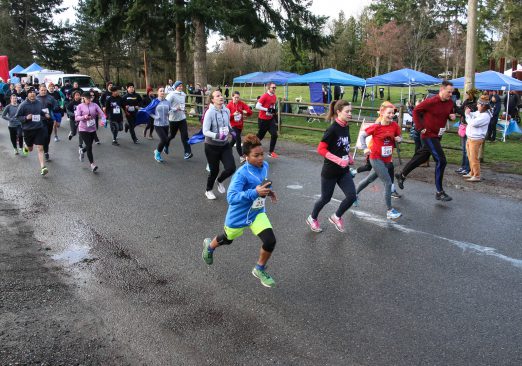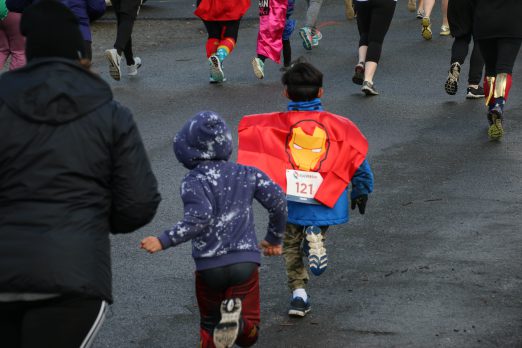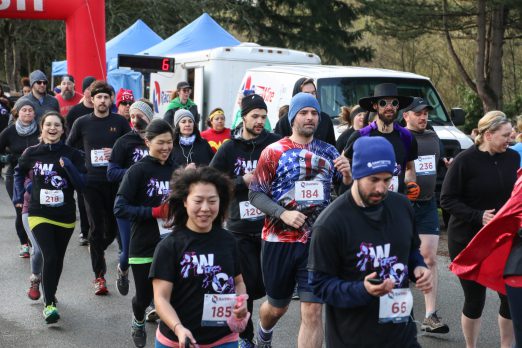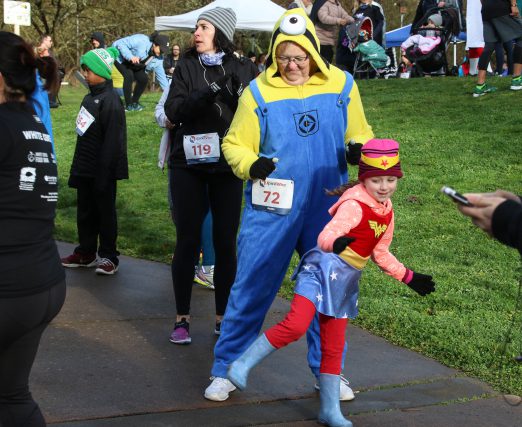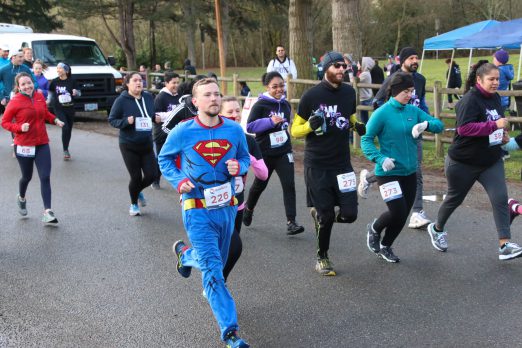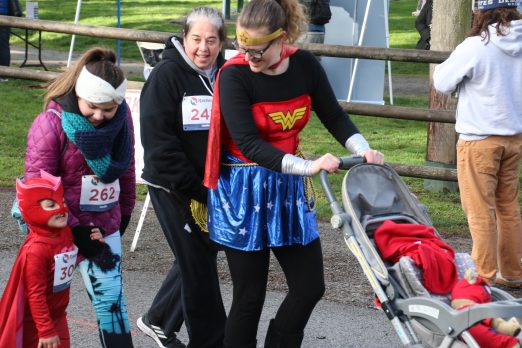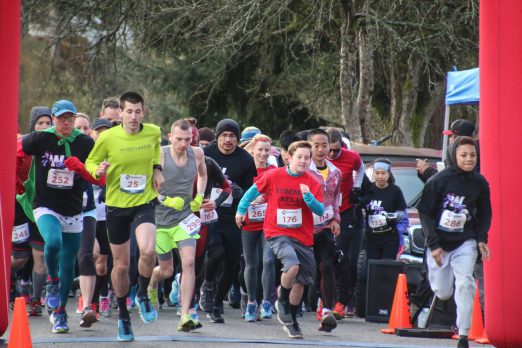We’ll be following up on this Wednesday: King County Sheriff’s Office Deputy Bill Kennamer reported on Tuesday night that “The Liquor Cannabis Board, with assistance from the King County Sheriff’s Office, served a search warrant at The Smoke Shop at 9823 16 Ave SW. A significant amount of illegal and untaxed marijuana and a pistol gripped shotgun were recovered.”
Search warrant served at Smoke Shop
March 27th, 2018 at 11:45 pm Posted in King County Sheriff's Office, White Center news | 2 Comments »
SATURDAY: Breakfast benefit for WCCDA at Lil’ Woody’s
March 26th, 2018 at 6:57 pm Posted in How to Help, White Center news | 2 Comments »
Lots of pre-Easter fun this Saturday … and you can fuel up for it with a benefit breakfast in downtown White Center:
Lil Woody’s White Center will partner with the White Center Community Development Association (WCCDA) for their quarterly neighborhood breakfast feed fundraiser.
The family-focused events harken back to a time when the White Center space was once home to the Epicure restaurant, a major gathering spot in the 1950’s- known to be where “the elite meet to eat.” The “EP” as it was called, was owned and operated by Joe Boothby, who cooked roast beef on a spit near the front window. The meat became a favorite offering of the restaurant, along with the annual pancake breakfast fundraisers held downstairs.
On Saturday, March 31, from 9 am-11 am, Lil Woody’s will be flipping lots of pancakes. The cost of the breakfast is $5 for kids and $10 for adults. 100% of the proceeds will benefit the WCCDA. Marcus Lalario of Lil Woody’s says: “We think it’s great to be located in a building that has played such a great role in White Center’s history. These breakfasts are a nod to that past and by pairing up with the WCCDA, we can give back to the community that supports us.”
Menu:
Food: Pancakes |Scrambled eggs |Bacon
Drinks: Mimosas |Caffe Vita Coffee
VIDEO: 250 superheroes run and walk in White Center 5K 2018
March 24th, 2018 at 10:42 am Posted in White Center Community Development Association, White Center Food Bank, White Center news | Comments Off on VIDEO: 250 superheroes run and walk in White Center 5K 2018
And they are off! Raising $ for @wccda @YESofWC @FeedWhiteCenter pic.twitter.com/uBkpbixE1s
— White Center Now (@whitecenternow) March 24, 2018
10:42 AM: Those are some of the ~250 people (and a few dogs!) who hit the road for this morning’s White Center 5K. The run/walk, which started and finished at White Center Heights Park, again carried a “superhero” theme – and everyone who participated was a superhero by raising money for the White Center Community Development Association, White Center Food Bank, and YES Foundation of White Center. We’ll be adding photos shortly!
ADDED 12:22 PM: As promised:
(WCN photos by Patrick Sand)
UPDATE: Deputies arrest suspect in White Center bank robbery
March 22nd, 2018 at 1:13 pm Posted in Crime, King County Sheriff's Office, White Center news | Comments Off on UPDATE: Deputies arrest suspect in White Center bank robbery
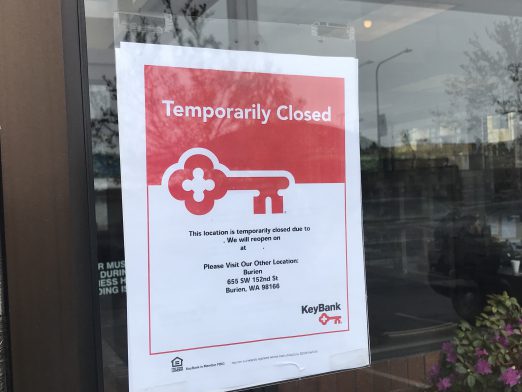
1:13 PM: Thanks to the tipster who asked about a large police response in White Center. The King County Sheriff’s Office confirms that they’re investigating a bank robbery that happened around 12:30 pm, at the KeyBank on 17th SW. No one reported to be in custody yet. More as we get it.
1:25 PM: Added the photo above. We asked KCSO spokesperson Sgt. Ryan Abbott for any description information about the robber – “Black man in his 20’s, 5’5″, slim build. Facial hair, black hoodie, with a bag.”
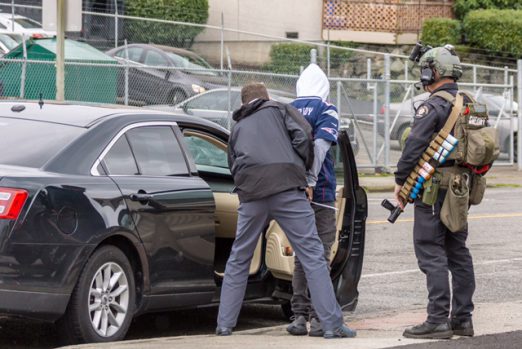
(Photo courtesy Aaron Wells Photography)
4:18 PM: After deputies tracked a suspect to a Boulevard Park apartment building near S. 118th and Des Moines Memorial Drive, the SWAT team came in to work toward arresting him. Within the past hour, they succeeded in taking him into custody, Sgt. Abbott confirms.
9:22 PM: Additional details in a news release from Sgt. Abbott:
Today, 03/22/2018 at 1230 PM, a bank robbery occurred at the Key Bank, 9600 BLK of 17 Ave. SW in White Center. The (robber) implied that he had a gun to the teller inside the bank, and fled the scene after the robbery. Video surveillance was quickly obtained … and Deputies were able to track him down at an apartment complex in Burien at the 1800 Block of S 118.
Once Deputies arrived on scene, they found a bag of money that had been thrown off the balcony of an upper apartment unit. Deputies on-scene were able to obtain information from witnesses, which led them to the exact apartment where the suspect had barricaded himself in. The Deputies experienced multiple failed attempts to get the suspect out of the apartment unit. KCSO’s SWAT team was called out to the scene. The suspect saw the armored SWAT vehicles arriving, along with the SWAT members, and surrendered to Police. The suspect was arrested without incident. No one was injured; this was an excellent job by all Deputies and Detectives on scene.
The 19 year old suspect was booked into KCJ for robbery.
We checked, and he does not appear to have a record; the definitive word on that will come as his case makes it through the court system – we will follow up.
VIDEO: Evergreen, Cascade students join national walkout
March 14th, 2018 at 10:48 am Posted in Schools, White Center news | 1 Comment »
17 seconds of silence. pic.twitter.com/RHESoZNjYC
— West Seattle Blog (@westseattleblog) March 14, 2018
Our first video clip includes the 17 seconds of silence observed by Evergreen High School and Cascade Middle School students this morning as they joined in the national student walkouts marking one month since the school massacre in Florida. They also chanted and heard fellow students’ speeches before going back to class after about 20 minutes of gathering.
'Choose our lives/over guns' pic.twitter.com/hvOeWehKdN
— White Center Now (@whitecenternow) March 14, 2018
Thanks to the students who invited us to be there to cover their gathering in the lot on the northwest side of campus.
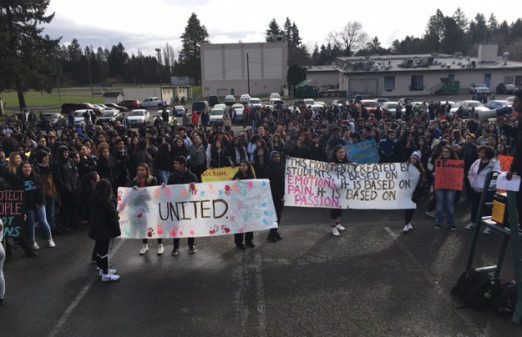
ADDED: Video of the students who spoke:
KCSO warns of frightening scam – telephoned kidnap claims
March 13th, 2018 at 3:27 pm Posted in Crime, King County Sheriff's Office, White Center news | Comments Off on KCSO warns of frightening scam – telephoned kidnap claims
Just in from the King County Sheriff’s Office, an alert about a terrifying scam, with one call made to someone living in our area:
In a span of 4 days, a new *SCAM* has surfaced. Male suspect or younger sounding female claims they have kidnapped the caller’s kids and won’t return them without money.
On 03/08/2018 in the Ravensdale area, a Mom had dropped her two kids off at the school bus in the morning. A short time after the bus left, the mom got a call from a blocked number. The male caller, described as having an accent, stated that he had her daughter and used her real name, although he had her last name slightly wrong. He told the mom that if she didn’t meet him with money in exchange for her daughter’s release he would “kill the child.” In a panic, the mom called the school and confirmed both her daughters were in school and safe.
Four days later, on 03/12/2018 in unincorporated King County near White Center, a father received a phone call from a blocked number. A younger-sounding female came on the line pretending to be the daughter of that father. The female stated she was kidnapped and the suspect needed money to release her. The male suspect, again described as having an accent, then got on the phone and demanded money from the father or he “would hurt her.” The suspect then hung up on the father and the number was blocked so he had no way to call back. The father called his daughter’s school and, once again, was assured the child was safe at school with no issues.
Please keep in mind these type of phone calls are *SCAMS* – never provide money to anyone over the phone.
The parents did the right thing in these instances – confirmed with the school their kids were ok and called 911 to report it.
TALK ABOUT IT: Highline Public Schools sets dates to discuss safety
March 12th, 2018 at 10:17 am Posted in Safety, Schools, White Center news | Comments Off on TALK ABOUT IT: Highline Public Schools sets dates to discuss safety
Just out of the inbox, from Highline Public Schools:
Highline Public Schools Invites Community to Talk Safety
Meetings on School Safety Begin March 22In response to recent incidents of school violence, Highline Public Schools is initiating a conversation with the community around school safety. Community meetings are being held at the four comprehensive high schools. Families, community members, and staff are invited to learn about safety plans and procedures and engage in a conversation about how to work together to improve school safety.
Thursday, March 22, 6:00 – 7:30 p.m.
Evergreen High School library
830 SW 116th StreetThursday, April 19, 6:00 – 7:30 p.m.
Highline High School library
225 South 152nd Street, BurienTuesday, May 1, 6:00 – 7:30 p.m.
Tyee High School library
4424 South 188th Street, SeaTac
Thursday, May 10, 6:00 – 7:30 p.m.
Mount Rainier High School library
22450 19th Avenue South, Des Moines
SATURDAY: Crab feed to support Evergreen High School Athletics
March 9th, 2018 at 12:49 pm Posted in Evergreen High School, How to Help, White Center news | Comments Off on SATURDAY: Crab feed to support Evergreen High School Athletics
Tomorrow’s the big night – Saturday, March 10th, the Crab Feed to raise money for Evergreen High School Athletics! 6-10 pm, be at the White Center Eagles‘ hall (10452 15th SW). Aaron Garcia sent the remidner:
Thank you to all those who bought tickets and we’ll be joining us this Saturday, we’re looking forward celebrating with you. We’re going to have delicious crab prepped by the legendary Tyrone Curry Sr, Live Music, Raffle and overall a ton of fun!
If you haven’t bought a ticket yet, please jump on this opportunity to support Evergreen High School Athletics! Remember 100% of the proceeds go toward Evergreen HS athletics and activities and this dinner is entirely supported by donations and volunteers!
You can buy your ticket online right now.
COUNTDOWN: White Center 5K 2018 getting closer!
March 8th, 2018 at 1:48 am Posted in Fun, White Center 5K, White Center news | Comments Off on COUNTDOWN: White Center 5K 2018 getting closer!
A little over two weeks until this year’s White Center 5K!
Signed up yet? If not – go here. It’s big fun on the morning of Saturday, March 24th, with racers starting at 9 am, walkers 10 minutes later. Three WC nonprofits (White Center CDA, YES Foundation of WC, White Center Food Bank) benefit from the proceeds, and you benefit from a morning of superhero-themed fun. Note that:
Registration includes a free T-SHIRT!
The course is pet-friendly, stroller-friendly, and wheelchair-accessible.
Race packet can be picked up at White Center Heights Park on race day at 7:45 AM.
Questions? Email us at whitecenter5k@gmail.com
WC Heights Park is where it all begins – 7th SW and SW 102nd.
WHITE CENTER RESTAURANTS: Opening day for Brass Knuckle Bistro
March 6th, 2018 at 12:49 pm Posted in Food, Restaurants, White Center news | 1 Comment »
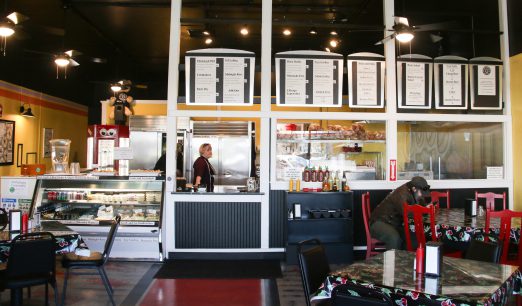
It’s opening day at Brass Knuckle Bistro, as we first noted last month, six months after introducing you to the West Seattle family behind the new eatery.
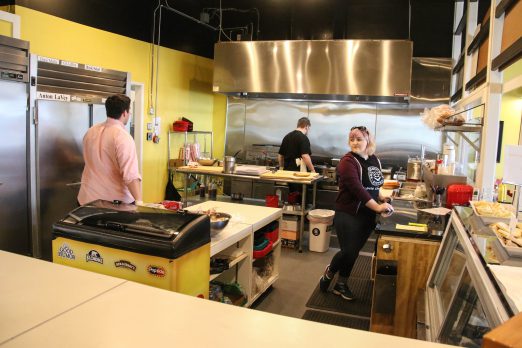
Check out the art:
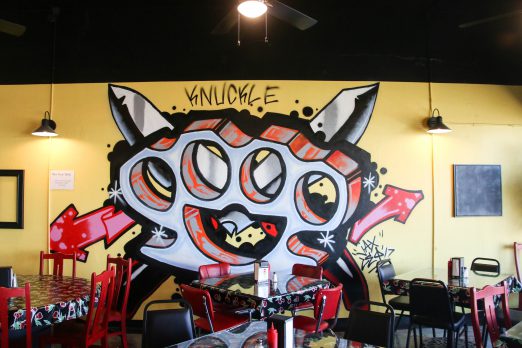
Sandwiches are the BKB specialty, along with salads and sides. See the menu here. We spotted today’s samples:
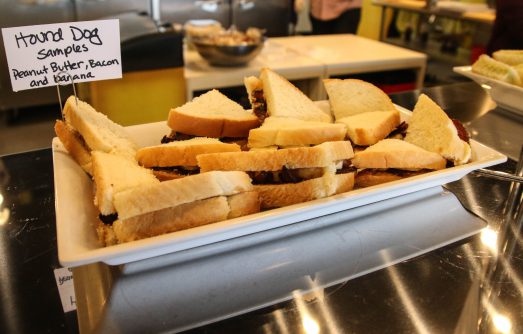
Brass Knuckle Bistro is open 11 am-8 pm Tuesdays-Sundays, closed Mondays.
FOLLOWUP: Double-murder suspect charged
March 5th, 2018 at 11:56 pm Posted in Crime, White Center news | Comments Off on FOLLOWUP: Double-murder suspect charged
Merle Buchanan is now charged in the January 6 double murder in White Center. We reported Saturday night on the arrest of the 26-year-old suspect, more than a month after the King County Sheriff’s Office announced he was being sought in the deadly double shooting.
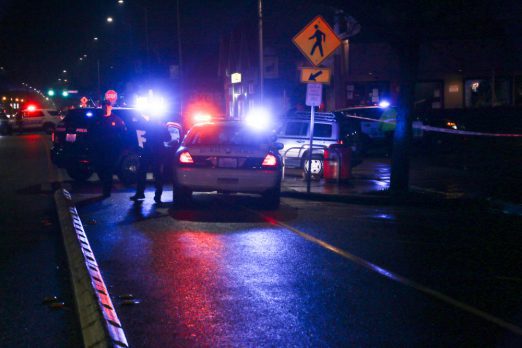
(WCN photo, January 6th)
Today, the King County Prosecuting Attorney’s Office charged Buchanan with two counts of second-degree murder and one count of second-degree unlawful firearm possession. Charging documents say the victims, Paul Tapia and Jose Garcia, were co-workers, and that they arrived together at the Taradise Café just after midnight. Buchanan, a White Center resident, is described as a semi-regular who had been there about an hour by then. The court documents say surveillance video showed him talking with Tapia outside the bar, by his car, with Garcia nearby, and then showed the shooting around 1 am. The charging documents do not mention a motive. They do say Buchanan was identified via a trail that started with an AutoZone receipt found at the scene. He is in jail in lieu of $1.1 million bail, including $100,000 related to a domestic-violence protection order violation charge involving an incident with a former girlfriend hours before the shootings.
VIDEO: North Highline Unincorporated Area Council gets gang briefing, encampment update
March 4th, 2018 at 11:53 pm Posted in North Highline UAC, White Center news | 3 Comments »
(NHUAC March 1, 2018, meeting recorded as livestreamed by David Krause)
By Linda Ball
Reporting for White Center Now
Some good news about gang activity in White Center/Burien, according to Detective Joe Gagliardi with the King County Sheriff’s Office: Most of the trouble has settled down since what he said was an eight-month gang war in the area last year.
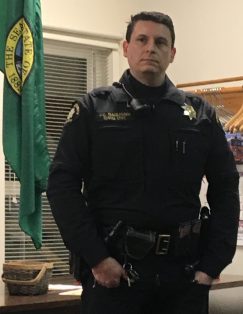 Det. Gagliardi addressed about 30 people Thursday night (March 1st) at the monthly meeting of the North Highline Unincorporated Area Council at NH Fire District headquarters. Gagliardi is the gang expert for KCSO and the head of its gang unit.
Det. Gagliardi addressed about 30 people Thursday night (March 1st) at the monthly meeting of the North Highline Unincorporated Area Council at NH Fire District headquarters. Gagliardi is the gang expert for KCSO and the head of its gang unit.
Most of us have the idea of what gangs are supposed to look like from what is depicted in movies, television, and mass media, he said. However, the reality is different because most of those images are dated. “Race doesn’t mean a thing – it’s about where you’re from and your neighborhood,” he said. In fact, the leader of the “Mexican Mafia” was white, he added. Gagliardi said gang members tend to have other things in common such as poverty, or abuse and neglect when they were children. Gang affiliation is often passed down through generations. Age is not a barrier either, because the younger they start, they’ll just go to juvenile detention for a short time, and be back on the street.
Although things have calmed down in White Center and Burien, that doesn’t mean gangs aren’t here. The two distinct sub-cultures in King County are L.A. and Chicago based gangs. (For their names and other details, watch Gagliardi’s presentation in the NHUAC video embedded above – he spoke right at the start of the meeting, until about 51 minutes into the video.) They all have their own distinctive colors, numbers, and sometimes symbols.
To recognize gang graffiti as opposed to taggers who consider their graffiti as art, he said it’s important to recognize that gang graffiti has a purpose. It’s not very artistic – for example, gangs do not use bubble letters, rather their tags are very linear, monochromatic, and meant to claim territory or issue a challenge.
Gang graffiti tells police which gangs are active in the area, which gangs are allies, which gangs are enemies and what areas they claim as their territory. “It’s an incredible intelligence source for us because it names active gang members,” he said. That’s because they usually include their street names in what is called a roll call. The other types of gang graffiti are for publicity, issuing a threat, expressing sympathy for a fallen member, political statements or simply to claim territory.
What he told those at the meeting was to NOT strike out a gang message and write your own graffiti next to it, because it is considered an act of disrespect and you could set yourself up for violent retaliation. Call the police when you see new graffiti, paint over it as soon as you can to deter recurrence, but not before the police come out – or at least before you take a photo of it yourself. If you believe it’s gang graffiti, be sure to call it in rather than reporting it online, he said.
Although the “artistic” taggers aren’t gang members, it’s still vandalism. They tend to go for high-visibility locations, like freeway overpasses so they can “share” their art. They’re the taggers responsible for vandalism via sticker, too. The good news, Gagliardi said, is that there has been no gang tagging recently in the area.
In Q&A, the detective was asked about gunfire along Myers Way last year. Was it gang-related? He said he had no specific information about it, but said that if and when gunfire/suspected gunfire happens – anywhere – call 911.
CAMP SECOND CHANCE: Josh Castle and Amy Friedman with the Low Income Housing Institute visited NHUAC with an update on Camp Second Chance, the City of Seattle-sanctioned encampment along Myers Way, just north of the city-county border. Presently, there are eight tiny houses on site, approximately 120 square feet, and LIHI has upgraded 10 tents that were in disrepair to sturdy shelter lodging tents. Castle said his vision was to eventually replace all the tents with tiny houses, which are built on skids so as to be easily moved. The tiny houses are not paid for by the city – Castle said it’s a community effort.
There are now about 50 residents in the drug-and-alcohol-free community. Electricity is available in the camp, and some of the tiny houses do have electricity so they have heat. Of course, the long-term solution to the homeless crisis is for people to transition into permanent housing, and Castle said about 300 people from the various city-sanctioned camps have made the move into permanent housing.
Also not tolerated in the camp is violence. Friedman, who serves as case manager at the camp, said she has never felt unsafe, as everyone in the community is very independent and enthusiastic about the community. Her job is to help residents find employment and other resources to help them get back on their feet. “I genuinely enjoy working with everyone at the camp,” Friedman said.
Not everyone is as enthusiastic about the camp, however. Neighbor Pat LeMoine, who has lived on Myers Way for more than 20 years, said the encampment is a “magnet” for trouble. LeMoine said in the past three years his neighborhood has become a “war zone.”
“What you guys are doing is traumatizing my lifestyle,” LeMoine said. “My neighborhood is in a state of terror.” He referenced the “landslide” of trash, visible from highway 509, from unauthorized campers nearby. He and his partner Carol Sivertz, have called 911 numerous times reporting gunfire, open drug use, and even a two-by-four left in his driveway used to smash into a neighbor’s vehicle. He said he was probably next, but he scared the perpetrator off.
Castle said the trash was not associated with the camp, with Friedman adding that the residents of Camp Second Chance are equally frustrated with the bad element nearby. It didn’t matter to LeMoine, who said he’d be happy to see the encampment go when its time is up.
CRIME AND SAFETY: KCSO Captain Rick Bridges and Storefront Deputy Bill Kennamer reported that resources were being spent in downtown White Center on the block of 16th Ave. SW that is home to several bars and restaurants where there has been some trouble, including the January double murder (for which a suspect was arrested a day after the meeting, as reported here).
DISABLED AMERICAN VETERANS: Another guest at the meeting talked about the DAV’s chapter located in West Seattle at 4857 Delridge Way SW, where they have monthly meetings, third Saturdays, 11 am. If you’re a veteran in need, check them out – here’s their website.
The North Highline Unincorporated Area Council meets first Thursdays most months, 7 pm at North Highline Fire District HQ. Check northhighlineuac.org for updates.
CAMP SECOND CHANCE: City of Seattle sets meeting for comments on 2nd-year permit
March 4th, 2018 at 2:51 pm Posted in Myers Way, White Center news | 1 Comment »
Just announced at the monthly Camp Second Chance Community Advisory Committee meeting: The City of Seattle is reviewing whether to renew the permit for the sanctioned encampment to remain at its site on the city-owned Myers Way Parcels for a second year, and as part of the renewal process, a community meeting is now set for 6:30 pm Tuesday, March 20th, at the Joint Training Facility (which is near the camp, 9401 Myers Way S.) If you can’t make it to the meeting, you can e-mail comments to homelessness@seattle.gov (write “Myers Way” in the subject line) and/or call 206-727-8496. The notice says comments will be accepted through April 5th.
Though the camp actually has been at the site for a year and a half (initially moving onto the Myers Way Parcels without authorization in summer 2016), its status as a city-sanctioned encampment didn’t officially start until March of last year, so that’s why the renewal discussion is happening now. We haven’t found the meeting announcement online yet but we photographed the flyer’s two pages – see them here and here.
Later tonight, we’ll publish our report on the rest of the meeting; the encampment also was discussed at this past Thursday’s North Highline Unincorporated Area Council meeting, and our report on that will be up soon too.
FOLLOWUP: White Center double-murder suspect Merle Buchanan in jail
March 3rd, 2018 at 8:41 pm Posted in Crime, White Center news | 1 Comment »
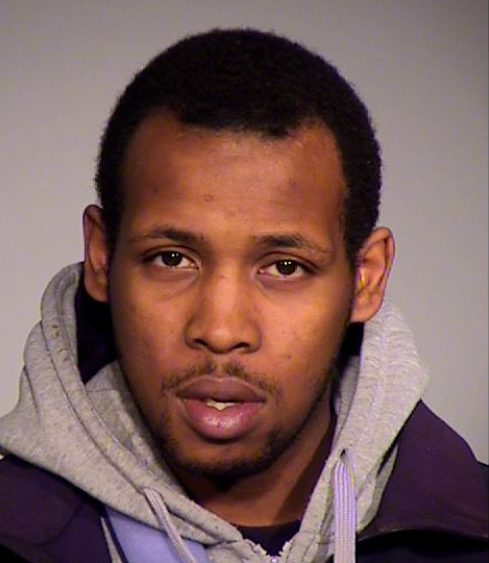 We’ve been checking the King County Jail roster periodically to watch for the arrest of Merle Buchanan, who’s been wanted for weeks in connection with the double murder in White Center two months ago. Tonight, we found his name on the roster. The King County Sheriff’s Office announced on January 25th that they were looking for him, almost three weeks after the shooting deaths in downtown White Center. Buchanan, 26, was booked on Friday afternoon, according to the jail register, with bail set at $1.1 million – including $100,000 for a domestic-violence-related warrant. Court records show he is not yet charged in the shooting deaths.
We’ve been checking the King County Jail roster periodically to watch for the arrest of Merle Buchanan, who’s been wanted for weeks in connection with the double murder in White Center two months ago. Tonight, we found his name on the roster. The King County Sheriff’s Office announced on January 25th that they were looking for him, almost three weeks after the shooting deaths in downtown White Center. Buchanan, 26, was booked on Friday afternoon, according to the jail register, with bail set at $1.1 million – including $100,000 for a domestic-violence-related warrant. Court records show he is not yet charged in the shooting deaths.
WHITE CENTER SCENE: On a log at The Bog
March 1st, 2018 at 5:58 pm Posted in White Center news, Wildlife | 1 Comment »
Beautiful day at White Center’s bog – thanks to Gill Loring for sharing the photo of the waterfowl enjoying the almost-spring weather.
Gang detective, encampment operator on March 1st agenda for North Highline Unincorporated Area Council
February 25th, 2018 at 7:17 pm Posted in North Highline UAC, White Center news | Comments Off on Gang detective, encampment operator on March 1st agenda for North Highline Unincorporated Area Council
Next monthly meeting of this area’s community council, the North Highline Unincorporated Area Council, is on Thursday (March 1st) – here’s the announcement of what’s planned:
North Highline Unincorporated Area Council Meeting
When: Thursday, March 1, 2018 at 7 pm
Where: North Highline Fire Station at 1243 SW 112th Street in White Center
(Parking and Entrance are in the Back of the Station)The Opportunity to Be Informed, Be Involved and Be Heard!
This month’s NHUAC meeting will include Detective Joe Gagliardi of the King County Sheriff’s Office. Detective Gagliardi is a highly regarded expert on gangs. Have you wondered whether the graffiti you’ve been seeing is gang related? Have you heard stories about local gang activity and crime? Don’t miss this rare opportunity to learn from the expert.
Captain Rick Bridges, KCSO’s new head of Operations for Precinct 4, and Deputy Bill Kennamer, White Center’s Storefront Deputy, will fill us in on other community concerns.
“DAV exists for veterans and their families. By fulfilling promises, we ensure America’s bravest sons and daughters are never forgotten.” North Highline community member Wendell Davis will introduce us to Disabled American Veterans and its local chapter on Delridge.
Also joining us will be Josh Castle of the Low Income Housing Institute. In 2013, LIHI partnered with Nickelsville to host and operate a homeless camp in Seattle. Today, LIHI manages several Seattle sites, including Camp 2nd Chance on Myers Way. Josh will share the latest news about our homeless neighbors living just over our border with Seattle.
Then… floor will be yours!
Knowledge is power. Learn, share and help make our community a better place.
March 1, 2018 at 7 pm – Bring a Neighbor!
WHITE CENTER FOOD: Brass Knuckle Bistro sets opening date
February 23rd, 2018 at 11:42 am Posted in Businesses, Food, Restaurants, White Center news | Comments Off on WHITE CENTER FOOD: Brass Knuckle Bistro sets opening date
It’s been almost six months since our first reports that Brass Knuckle Bistro was on the way to the former 3.14 Bakery space at 9602 16th SW. Now they’ve announced that March 6th will be the opening date, with a “friends and family” event this weekend for other local businesses. BKB will focus on sandwiches – you can preview the menu online. (Thanks to Gill for the tip!)
FOLLOWUP: A Dog’s Dream now open in White Center
February 22nd, 2018 at 2:35 pm Posted in Businesses, Pets, White Center news | Comments Off on FOLLOWUP: A Dog’s Dream now open in White Center
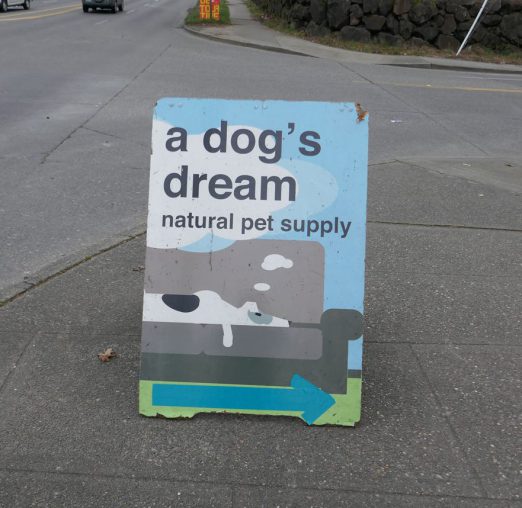
(Photo courtesy Gill Loring)
We first told you last month that A Dog’s Dream Natural Pet Supply was adding a White Center location. And now its doors are open. The announcement sent to WCN:
We are now open!
Our hours are 10-7, seven days a week.
We will be hosting a Grand Opening/12th anniversary weekend event March 3rd and 4th, where we will be offering 20% off all purchases at both stores.
The White Center store is at 9620 14th SW; the original location is at 5913 Airport Way S. in Georgetown.
SNOW AFTERMATH: School changes for Thursday
February 22nd, 2018 at 6:04 am Posted in Schools, Weather, White Center news | Comments Off on SNOW AFTERMATH: School changes for Thursday
(UPDATED 6:25 AM)
The snow has stopped, but what’s on the ground has stayed. School changes:
From Highline Public Schools:
All schools are on a two-hour delay on Thursday, February 22. Buses will stop at their alternate bus stops—two hours later than normal. https://t.co/6bmM6eIIJE pic.twitter.com/vEAi5bsSRy
— Highline Schools (@HighlineSchools) February 22, 2018
Holy Family Bilingual School – 1 hour late. BASS available at 8, school starts at 9
Anything else we should know? Text or call our 24/7 hotline – 206-293-6302 – thanks!
FOLLOWUP: Pedestrian hit by Metro bus in White Center
February 20th, 2018 at 2:55 pm Posted in King County Sheriff's Office, White Center news | Comments Off on FOLLOWUP: Pedestrian hit by Metro bus in White Center
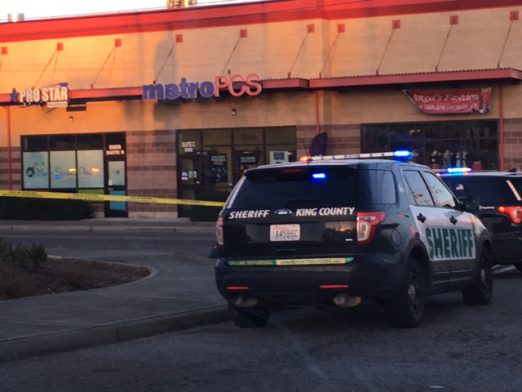
On Sunday, we reported on an incident that sent a pedestrian to the hospital after he was hit at 15th/100th. Few details were available at the time, but we have just obtained more information now from KCSO Sgt. Ryan Abbott:
It appears a 59-year-old male was struck by a 60’ long double articulated Metro bus which was southbound on 15 AVE SW approaching SW 100. The driver stopped at the Metro stop near the NW corner of the intersection. The victim was on the west sidewalk and stumbled off the sidewalk and into the path of the bus as it drove away. The right rear tires of the bus struck the victim and he sustained critical leg injuries.
The driver had no idea he had struck the pedestrian and the 40-50 passengers on the bus at the time also did not notice that the pedestrian was struck. The victim was transported to Harborview for treatment.
No information yet on how the victim is doing.


